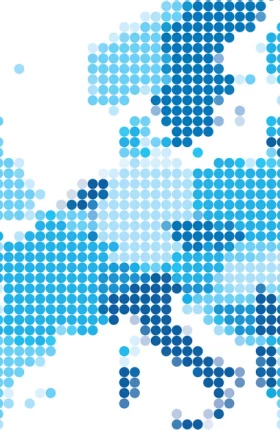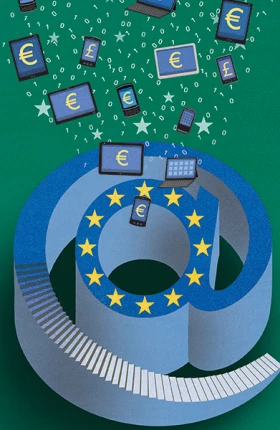The European Union has set ambitious goals in its vision for a Digital Single Market (DSM) that would ensure the free movement of goods, services, people, and capital—and with good reason. The EU’s Internet economy, or eGDP, contributes some €700 billion a year to GDP (5 percent of total GDP), and Europe’s high-tech sector employed almost 8.5 million people in 2013. And this is just the tip of the iceberg.
We estimate that Europe’s eGDP will contribute almost €1.1 trillion, or 7.5 percent, to Europe’s total GDP in 2020, that the Internet economy will grow up to 13 times faster than the economy as a whole, and that eGDP growth will represent some 40 percent of overall economic growth for the decade from 2010 to 2020. According to the European Commission, cloud computing and the app economy will create an additional 3 million jobs in Europe by 2020. The next wave of growth will be propelled in part by the Internet of Things, which is expected to contribute almost €330 billion of new revenues in Europe by 2020.
The EU has come a long way, but Europe can do more. As we detail in a new report, Europe’s digital ecosystem trails that of other developed countries in North America and Asia. Europe’s share of the global consumer-oriented information- and communication-technology market is expected to decline by 2 percentage points by 2019 as other regions grow more quickly. Across the four segments of the digital sector—telecommunications, “over the top” (OTT) content and service providers, TV and other broadcast, and operating systems and devices—Europe’s market share is expected to stay flat or fall. (See Five Priorities for Achieving Europe’s Digital Single Market, BCG report, October 2015.)
There are multiple reasons why Europe is playing catch-up, and out-of-date regulatory policy is one. The EU, while it points to the many benefits of a DSM, continues to regulate according to a system based on national markets as well as market definitions that no longer apply. The European Commission’s strategy for achieving the DSM is an ambitious plan that points in the right direction. But its achievement requires that the right regulatory actions be taken. The second of the three pillars supporting the DSM strategy is “Creating the right conditions for digital networks and services to flourish, which requires high-speed, secure, and trustworthy infrastructures and content services, supported by the right regulatory conditions for innovation, investment, fair competition, and a level playing field.”
Within this pillar, we believe that digital policy makers should make the five topics discussed later in this article their top priorities. Success in these areas will have an outsize impact on how far and how fast Europe moves toward its DSM vision.
Two Trends Will Shape the Market
Markets move fast; regulations often play catch-up. This is especially true in technology-driven industries in which the speed of change can be fierce. Policy makers and regulators need to account for two big trends in their decision making.
The first is the convergence of technologies (mobile, fixed line, cable, and fiber), which is leading a concurrent convergence of digital services and of the companies providing these services. The new competitive playing fields being created are not necessarily level, and consumers are increasingly choosing among services that operate under different regulatory regimes and provide different packages of service quality and consumer protection, often without disclosure as to precisely what services are being provided and under what conditions.
For example, more and more voice communication is carried over the Internet. Similarly, text messages, a favorite communications vehicle for young people, is fast giving way to alternative Internet-based messaging platforms, which often involve commercial business models that do not charge customers directly. One result of this convergence is that the terms “network operator” and “OTT player” are not nearly as distinct as they once were. Network operators are offering content and services. Similarly, some OTT players partner with network operators to offer guaranteed quality services, such as guaranteed speed for video, to consumers. A few big OTT companies have gone so far as constructing their own networks and are actively experimenting with new network technologies. Deals between network operators and OTT players are increasingly common as companies recognize the commercial benefit of cooperation. All of which means that regulation based on old roles and old rules is more and more outdated.
The second trend is the ongoing investment that is necessary to build and maintain world-class networks that can handle fast-rising and rapidly evolving demand. The digital services that make up such a big and growing part of the Internet economy still rely on network operators to deliver them. So do the consumers and businesses that use them. As revenues and market share migrate to others, network operators have less money for, and fewer incentives to make, the infrastructure investments that are necessary to keep Europe digitally competitive. Some €216 billion of investment is needed to meet the EU’s digital goals. We estimate that approximately €110 billion of combined public and private investments are currently planned, leaving a gap of €106 billion.
Five Top Priorities
In our view, the five top priorities with respect to “creating the right conditions for digital networks and services to flourish” are the following:
- Ensuring consistent standards across digital services for consumers and a level competitive playing field for companies
- Facilitating investment by establishing optimum market structures that reduce fragmentation and allow for efficiencies of scale
- Rethinking wholesale market regulations—and acknowledging when there is sufficient competition across technologies to serve subnational markets
- Modernizing spectrum policies so that more and cheaper spectrum becomes available faster to accommodate exploding data-traffic volume
- Enabling specialized services to drive innovation
Ensuring Consistent Standards and a Level Playing Field. Creating consistent consumer-protection standards that apply to all service providers, whether traditional or purely digital, will be critical to ensuring a healthy and trusted digital ecosystem. To do so, regulatory regimes need to be modified to reflect new realities. For example, all services and service providers should be subject to the same standards of consumer privacy and data security, and all should be required to inform people of how data is used—no matter whether they charge money for a service or the consumer “pays” through data collection and advertising models.
The EU should pursue the following changes:
- Applying cross-sector regulation across digital services for basic protections such as data security, consumer protection, and consumer privacy
- Ensuring a level playing field within voice and text services, including clear disclosure by application-based services regarding the nonavailability of emergency services and the lack of network-grade service quality
- Observing and assessing the potential development of network effects that curb consumer choice or innovation within application-based services and stepping in if necessary
- Ensuring that there is no discrimination by player type for any application- or network-based digital service
Facilitating Investment by Optimizing Market Structures. The expectation, of course, is that the private sector will close the €106 billion gap in telecommunications investment that Europe faces. But most major European network operators saw their returns on capital shrink over the last four years; in fact, many still have returns below their cost of capital. There is little incentive for these companies to invest under current conditions.
European competition policy with respect to the telecommunications ecosystem—especially the criteria for merger review and the imposition of merger remedies—needs to be rethought for the digital age. Consolidation in a market can create stronger, healthier companies, and the big synergies realized in mobile-operator mergers can lead to much-needed investment.
This type of consolidation does not mean higher prices, as is often feared. Our analysis indicates that following the merger of four mobile players into three in Austria in 2013, prices on a per-unit basis for consumers fell by 40 percent—and capital investment in fixed and mobile rose by 10 percent in the first half of 2015.
Regulators should shift from price as the dominant regulatory objective to a more comprehensive and balanced assessment that includes investment, technical progress, innovation, efficiency, and quality of service. Market definitions should take a wider view of shifting demand for services, including the impact of OTT-based competition in voice and messaging. Price assessment should be based on per-unit prices rather than package costs, and infrastructure competition from fixed-line players should be included in regulatory reviews. Regulators should also shift the focus of merger remedies from new-player entry (usually enforced by reserving spectrum) to encouraging network investment and innovation as well as quality-of-service commitments from the merged entity.
Rethinking Wholesale Market Regulations. The wholesale telecommunications market has undergone radical change; regulations have not kept pace. Homes and businesses today are served by an array of telecommunications technologies that are converging to make high-speed access available through fiber and high-speed copper wires, coaxial cable, and mobile connections. There is strong evidence that the existing policy and regulatory framework has not led to the levels of investment needed to advance Europe’s digital infrastructure. A new, simpler, technology-agnostic, and more market-based approach is called for. It should be based on two principles: segmenting markets according to current competitive dynamics and making light-touch ex-post regulation the rule and ex-ante the exception.
Regulators should geographically segment markets in order to assess competition on a local level. For example, in Cologne, regulation continues to mandate wholesale access in a market that has three active competitors (and in which the incumbent actually has the lowest market share), and this is not an exception. Regulators should also assess competition in a technology-agnostic manner and include all competing technologies—cable and mobile, as well as fiber and copper—in the process. In noncompetitive areas, regulators can mandate wholesale access but hold mandates to one product per geography.
At the same time, competition and commercial arrangements should be the norm, with a provision for ex-post regulatory oversight and dispute resolution by national regulatory authorities based on nondiscrimination.
Modernizing Spectrum Policies. As we have argued many times before, policy makers need to allocate more spectrum for mobile. According to an ITU estimate, not a single EU member state has allocated half of the spectrum it will need by 2020, and some are looking at shortfalls of up to 70 percent. Governments must free up spectrum from current allocation, where it is often no longer needed—TV and military applications are two examples—and reallocate it for mobile use.
The allocation process also must be modernized and auction timetables aligned to increase the predictability of allocations for operators. Some countries held auctions for the 800-MHz band in 2010, and some only in 2015. The allocation process was supposed to have been finished by January 2013.
Several spectrum-sharing models also offer the potential to increase utilization through approaches that complement long-term, exclusive-use licenses. The requirements of the Internet of Things make spectrum release planning—including national spectrum plans—ever more important. Advancing HetNet (heterogeneous network) deployment can expand network capacity.
Transparent planning is required to manage the spectrum needs of the future, such as the enormous spectrum requirements for 5G networks. The UK is leading in this regard, with its ambitious spectrum strategy and governance model. A similar approach is needed across the EU.
Enabling Specialized Services to Drive Innovation. New and innovative digital services have enormous potential. Connected cars could save 25,000 lives in the EU annually. Mobile health monitoring has the ability to save European citizens 330 million doctor visits every year. But services such as these require guaranteed network quality. The key factor often is not speed but other considerations, such as low latency or high security.
The EU has already rightly taken a bold decision to pursue the implementation of specialized services with guaranteed network quality. The devil will be in the details. Allowing different commercially driven models to flourish, in part by ensuring the consistency of regulation across countries, can help enable the successful rollout of specialized services.
As the European Commission observed in May 2015, “When the Digital Agenda for Europe targets were set in 2010, they appeared extremely ambitious to many observers. Now midway to the targets, they are already insufficient and out of date in an increasing number of usage cases, in particular for industrial use by other sectors (for example, for connected cars) but also in telemedicine, cultural and creative industries, etc. … Today, while it is difficult to anticipate our connectivity needs in the future, we do know from current trends (e.g. video in all its professional and private uses, multiple uses and connections, wireless and mobile uses by people and connected objects) that those needs will increase significantly.”
Increasing needs put increasing demands on the networks that make up the Internet. The projected shortfall of €106 billion in the investments needed to secure the goals of the DSM looms large—but not so large that it cannot be overcome. Europe has made long strides in a few short years; it can pick up the pace of progress. Smart policy and regulation can provide much of the needed catalyst for achieving the goals of the DSM—and maybe even more.





